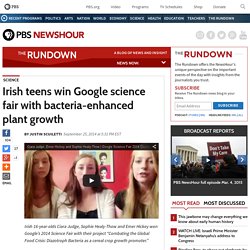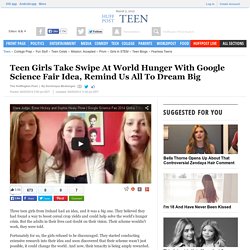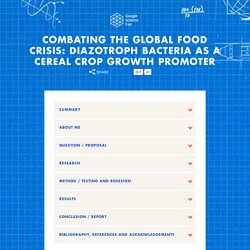

Irish teens win Google science fair with bacteria-enhanced plant growth. Irish 16-year-olds Ciara Judge, Sophie Healy-Thow and Emer Hickey won Google’s 2014 Science Fair with their project “Combating the Global Food Crisis: Diazotroph Bacteria as a cereal crop growth promoter.”

Three 16-year-old high school girls hailing from Ireland claimed the top prize for Google’s 2014 Science Fair with a project that aims to solve the food crisis — with the help of bacteria. The teenagers, Ciara Judge, Sophie Healy-Thow and Emer Hickey, found that by infecting crops with a certain type of bacteria, the plants would grow more quickly and therefore be able to yield more food. The bacteria, known as rhizobia, prove beneficial to the plants by converting nitrogen in the air into ammonia, which aids in the plants’ development. After 11 months testing more than 10,000 seeds, the three found that exposing the seeds to the bacteria halved the time for the plants’ germination, or process in which the plant grows from the seed.
Three Irish Teens Win Google Science Fair Using Bacteria to Grow Food. A trio of Irish high-schoolers nabbed the top prize in this year's Google Science Fair with a project that speeds up crop growth by tapping into the naturally cozy relationship between soil microbes and plants.

After 11 months of experiments, the three 16-year-olds—Ciara Judge, Émer Hickey, and Sophie Healy-Thow—found that seeds treated with bacteria sprouted 50 percent faster than untreated seeds did. At harvest, the microbes increased barley and oats yields by as much as 70 percent. (See "Why Tiny Microbes Mean Big Things for Farming. ") The improved sprouting speed is instrumental to farmers in Ireland, where seeds can rot in the damp soil before sprouting, Hickey said. The trio hails from Cork County, the agricultural southern tip of the country. But the project really kicked off in Hickey's own backyard. "Émer and her mom were gardening, and she noticed nodules on one of their pea plants," Healy-Thow said.
"Companies such as Monsanto have been doing this sort of work for a long time. Three Irish students win global science competition. Three Irish students have won a global science research competition at the GoogleScience Fair 2014 in San Francisco.

Ciara Judge, Emer Hickey and Sophie Healy-Thow from Kinsale Community School, Cork were named the grand prize winner in the 15 to 16-year-old age category for a project which examined the use of natural bacteria to increase crop output. They were inspired to try and help improve food production, particularly in third world countries, after learning about a famine in the Horn of Africa in 2011.
The basis of their project focuses on a naturally occurring bacteria in soil called Diazotroph. Their research showed that if Diazotroph is present, it accelerates the germination process of high-value crops such as barley and oats, potentially boosting output by up to 50 per cent. Detailed statistical analysis of their results indicated that these bacterial strains accelerated crop germination by up to 50 per cent and increased barley yields by 74 per cent.
The Science Squad. Teen Girls Take Swipe At World Hunger With Google Science Fair Idea, Remind Us All To Dream Big. Three teen girls from Ireland had an idea, and it was a big one.

They believed they had found a way to boost cereal crop yields and could help solve the world's hunger crisis. But the adults in their lives cast doubt on their vision. Their scheme wouldn't work, they were told. Fortunately for us, the girls refused to be discouraged. They started conducting extensive research into their idea and soon discovered that their scheme wasn't just possible, it could change the world. Ciara Judge, Émer Hickey and Sophie Healy-Thow. Hunger Statistics. Every year, authors, journalists, teachers, researchers, schoolchildren and students ask us for statistics about hunger and malnutrition.

To help answer these questions, we've compiled a list of useful facts and figures on world hunger. Some 795 million people in the world do not have enough food to lead a healthy active life. That's about one in nine people on earth. The vast majority of the world's hungry people live in developing countries, where 12.9 percent of the population is undernourished.
Asia is the continent with the most hungry people - two thirds of the total. Your Project - Google Science Fair. Bibliography and References Youtube Video Links For any extra information about the project please check out our Google+ or Youtube accounts!

References Ref 1: Baset Mia M.A., Shansuddin Z.H. and Mahmood M. (2010). ‘Effects of rhizobia and plant growth promoting bacteria inoculation on germination and seedling vigor of lowland rice’. Ref 2: Brewin N.J. (2010). Ref 3: Somasegaran and Hoben H.J. (1985). Ref 4: Graham P.H. and Vance C.P. (2003). Ref 5: Bhattacharjee R.B., Singh A. and Mukhopadhyay S.N. (2008). Hunger Facts - Stop Hunger Now.